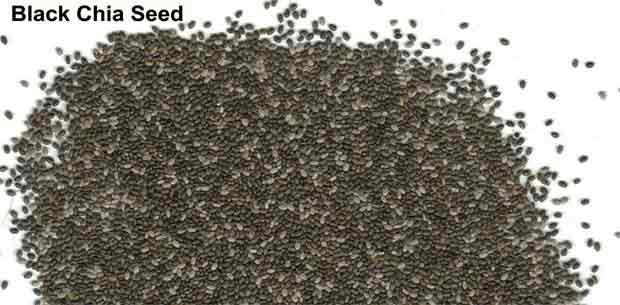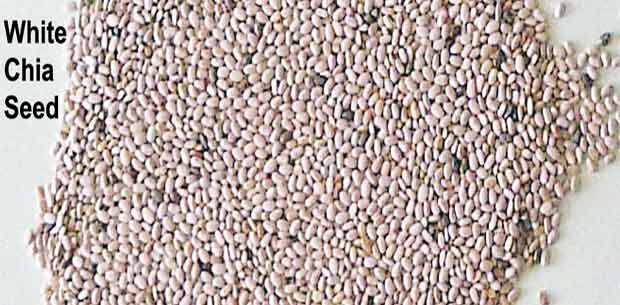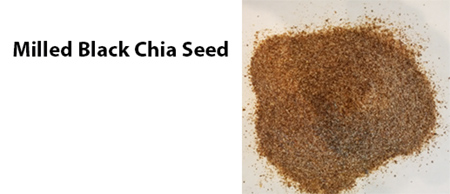Chia Seed Information
Chia (Salvia Hispanica L.) seed is interesting in several aspects. It is the richest plant source of omega-3 fatty acids known, and it contains natural antioxidants. The plant is a member of the mint family and originated in southern Mexico and Guatemala.
Although people commonly refer to it as chia, what they are really referring to is the seed of the plant, a member of the mint family (some refer to is as sage). Technically it is a seed, not a grain as some have called it. More specifically, it is an oilseed since the seed contains more than 30% oil.
There are two seed colors, white and black. Some claim that the white seeds are more potent, but this is not the case; if anything the black has more antioxidants. The black seeds, just as with dark fruits, are higher in antioxidants. Both seeds contain essentially the same amount of omega-3, protein, fiber, etc.
Basic Facts About Chia
- Richest natural plant source of omega-3 fatty acids
- Cholesterol free
- Does not need antioxidants/stabilizers
- No toxic or antinutritional factors
- Low saturated fatty acid content
- Sustainable and environmentally friendly product
- Easy handling for farmers & manufacturers
- Storage for years with no deterioration
- Ideal for enriching many different products
Good vs bad chia seed
Detailed chia seed analyses
Black vs white chia seed
Chia is the richest plant source of omega-3 fatty acids and contains natural antioxidants.
It is available as raw material for use in Functional Foods, Nutraceuticals and Dietary Supplements. Chia’s unequaled omega-3 fatty acid stability arises because of the natural antioxidants the seed contains. Oxidation of food lipids is a major concern for both consumers and manufacturers. If not controlled, oxidation can produce off-flavors (typically a fishy flavor), and promotes degenerative diseases associated with aging such as cancer, cardiovascular diseases, cataracts, immune system decline, and brain dysfunction. The natural antioxidants in chia gives it a tremendous advantage compared to all other sources of omega-3 fatty acids.
Chia has no cholesterol. This is different than fish products, all of which contain significant amounts.
For health conscious consumers this gives chia an important advantage compared to fish products.
Chia, when used as a source of omega-3 fatty acids, does not require the addition of artificial antioxidants such as vitamin E.
Vitamin E has been shown to nullify the protector effects of cardiovascular drugs, and actually promotes oxidation when used at higher levels.
Another α-linolenic rich crop is flax. However, this is primarily used to manufacture industrial products, such as coatings, floor coverings, paints and varnish.
Although many efforts have been made to use flaxseed for omega-3 food enrichment, the negative effects that the antinutritional factors in flax have on animal and human health arise. In order to safely use flax in a diet in any significant quantities, the seeds have to be detoxified. However, the most efficient processes require solvents, and still flax seed is not completely detoxified.
Chia is a natural source of omega-3 fatty acids and antioxidants
Chia, when added to animal diets, results in a dramatic reduction in the saturated fatty acid content of the products produced. This reduction is significantly greater than that found when feeding marine products (fish and algae) and flaxseed. Consumption of saturated fatty acids is associated with cardiovascular diseases, with their effects on blood low-density lipoprotein cholesterol (LDL) being stronger than those of dietary cholesterol. The difference between chia and other sources of omega-3 fatty acids in this regard has important implications for commercialization.
Eggs from hens fed chia have an α-linolenic fatty acid to DHA ratio similar to that found in human milk. When very high quantities of chia are added to the diet, α-linolenic elongation and desaturation are delayed, and DHA (a very unstable fatty acid) content remains constant. This means that if excess amounts of omega-3 are added to hen diets it is essentially stored as α-linolenic fatty acid. This metabolic behavior, together with the potent antioxidant activity of chia’s flavonols and cinnamic compounds, allows hens to produce eggs having greater stability to resist oxidation than eggs containing high DHA contents.
Chia is a sustainable and environmentally friendly product.
The high oil content of its leaves acts as an extremely potent insect repellent and eliminates the need for pesticides being used to protect the crop. The use of chia as an omega-3 source prevents depletion of natural fish stocks, and also eliminates concerns about the accumulation of toxins such as dioxin and mercury that may accumulate in fish and fish products. Solvent extraction and artificial preservatives are not needed when chia seed is used in human or animal diets. This is another advantage compared to omega-3 sources such as algae.
Chia can be stored for years without deterioration in flavor, odor or nutritional value.
This is an advantage compared with marine products since fish oil and fish meal as well as algae oil and powder require special packaging and storage conditions to prevent even minor changes in these characteristics occurring over time.
Chia is ideal for enriching a number of products such as infant formulas, baby foods, baked goods, nutrition bars, yogurt, sauces, etc.
When used as an animal feed omega-3 enriched products such as eggs, poultry, beef, pork, milk, cheese, etc. are produced. Chia is an excellent source of protein, minerals and vitamin B, is simple to use in feed preparation, and is safe for both humans and animals.
Chia has a long history as a human food, starting with its domestication by ancient Mexicans in 2,600 B.C.
Corn, Beans, Chia and Amaranth comprised the main components of the Aztec and Mayan diets when Columbus arrived in the New World. Some people are still using this ancient food in the preparation of a popular and refreshing beverage called “chia fresca” which is consumed in Mexico, Central America, as well as in California and Arizona.







